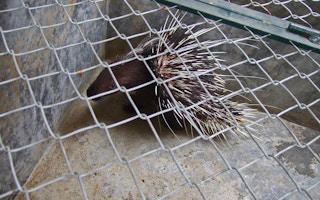The Covid-19 pandemic has made it clear that when coronaviruses leap from wild animals to humans, the results can be devastating. A new study from Vietnam provides new insights about how this cross-species spread might happen.
Researchers showed for the first time that as animals move through the wildlife supply chain, from their natural habitats to marketplaces and ultimately to restaurants, they are more likely to become infected with coronaviruses, according to a report in PLOS One. And at each stage, people interact with these animals more intensively.
Coronaviruses are most notorious for causing human disease—including SARS, MERS, and Covid-19—but they are widespread in the animal kingdom. There are many different coronaviruses, and they can infect bats, rodents, birds, and domestic livestock like cattle and swine. Understanding where and how these viruses first make contact with humans is critical for preventing future pandemics.
To do this, the best place to start is at the wildlife-human interface: places where wild animals and humans are exposed to each other. A team of Vietnamese scientists, led by Nguyen Quynh Huong and Nguyen Thi Thanh Nga, along with Amanda Fine and Sarah Olson of the Wildlife Conservation Society (WCS) in New York, tested field rats for coronavirus at different points along the wildlife supply chain in Vietnam. They found that with each link in this chain, the percentage of infected animals increased by about 1.5 times.
This factor may not seem like much. However, it means the infection rates increased markedly: 20.7 per cent of rats handled by wildlife traders, to 32 per cent of rats in the markets, to 55.6 per cent of rats in the restaurants.
“They did an amazing job at following the virus surveillance throughout the trade routes,” said senior field veterinarian Marc Valitutto of EcoHealth Alliance, who focuses on pandemic preparedness in Southeast Asia and China. Valitutto, who was not involved in the research, wasn’t aware of any other studies that traced infection rates along trade routes in as much detail.
The team also found that about 75 per cent of bats on guano farms (constructed roosts where people collect and sell bat droppings for fertiliser) were infected with coronavirus. That was more than ten times the infection rate of 6.7 percent in naturally roosting bats.
The study demonstrated that the animals in closest contact with humans had the highest infection rates, said Fine. That’s critical to understanding how coronaviruses might infect villagers or city residents: The chance that a virus will transfer from wildlife to people is “directly increased by the number of contacts and the number of humans in that environment,” she said.
Further, when infected animals reach markets and restaurants, they are often housed in close quarters near many different kinds of animals. In such settings, coronaviruses can jump from species to species, said Olson. The team found direct evidence of this: rats and porcupines on a crowded wildlife farm carried coronaviruses from bats and birds.
That’s a noteworthy public health concern, according to Valitutto: Many coronaviruses that have caused major human outbreaks have jumped among a few different species before infecting people.
The authors noted a few caveats. For instance, cross-contamination between animals butchered in restaurants could have created some false positives tests—although such contamination is another way coronavirus could spread to human consumers, said Fine. Also, virus infections among animals are much higher during the wet season, but the team couldn’t sample every testing site during both wet and dry seasons.
Fine, Olson, and Valitutto all hope the sobering results of this study will help bring major changes to wildlife trade regulation in Vietnam and elsewhere to cut down on coronavirus transmissions.
“If this can’t change the status quo,” said Olson, “I don’t think anything can.”
This story was published with permission from Mongabay.com.












